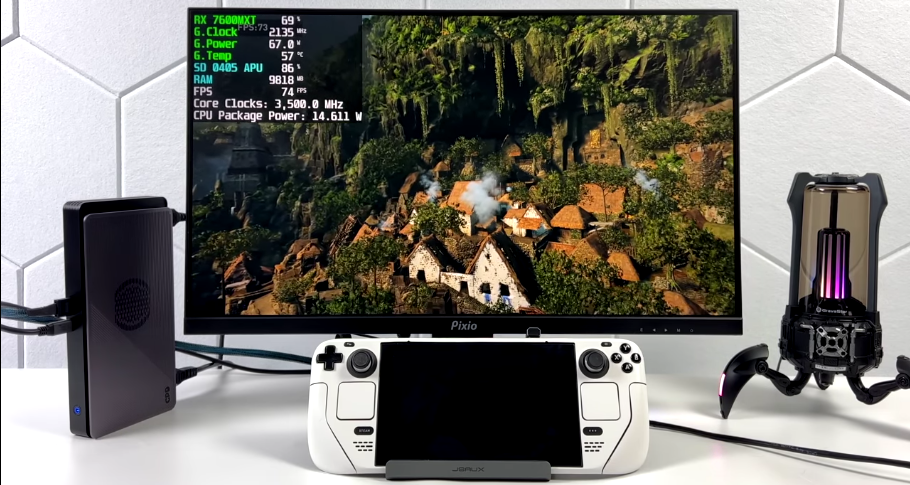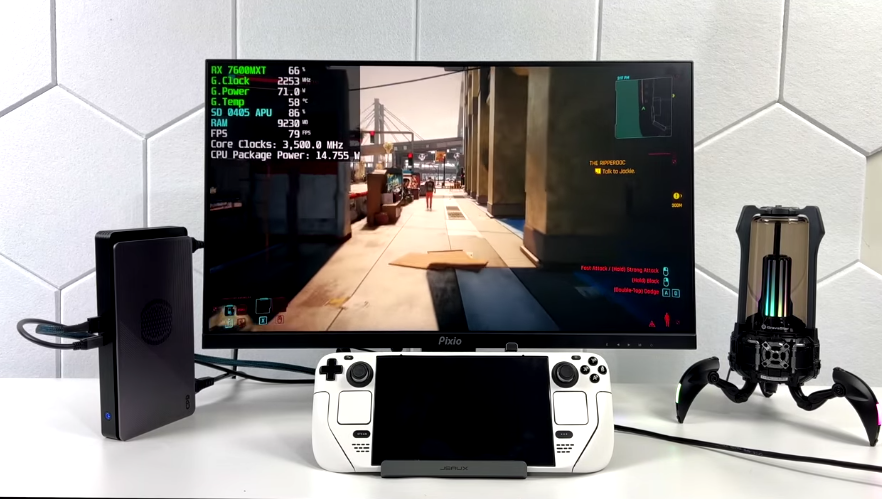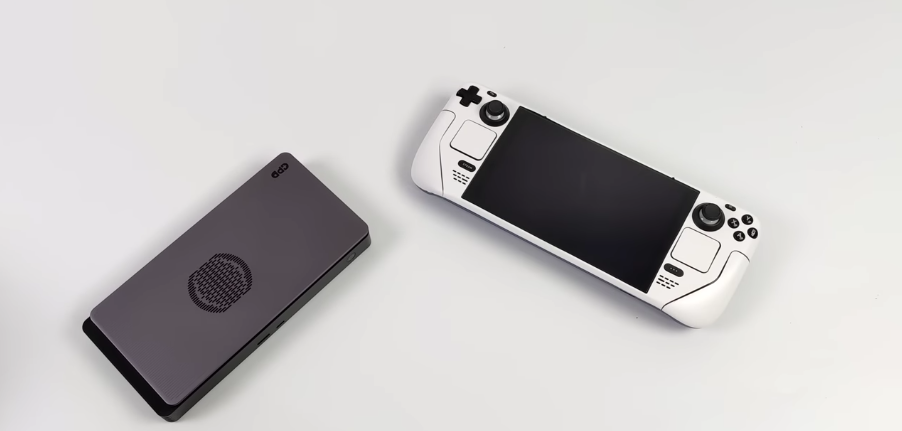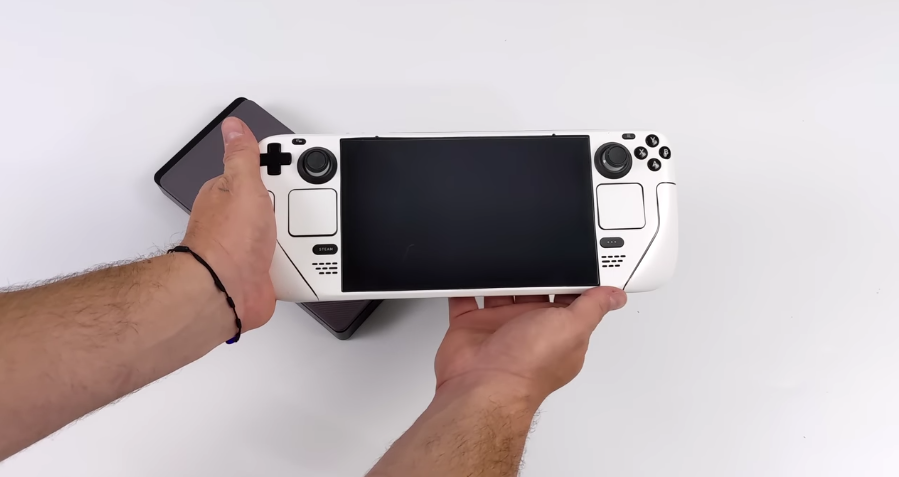Meet The Valve’s Gaming Marvel “Steam Deck GPU”
- 1 Steam Deck GPU Specifications
- 2 Why Are Steam Deck Graphics Different?
- 3 Introducing The Steam Deck GPU
- 3.1 Compute Units and Stream Processors
- 3.2 Ray Tracing Capabilities
- 3.3 Variable Rate Shading (VRS)
- 3.4 Performance Metrics
- 3.5 Display Technology
- 3.6 Storage and Expandability
- 3.7 Software and Compatibility
- 4 Should I buy it?
- 5 Conclusion
- 5.1 Frequently Asked Questions
- 5.1.1 What operating system does the Steam Deck run?
- 5.1.2 Can I play games from platforms other than Steam on the Steam Deck?
- 5.1.3 Is the Steam Deck comparable to other handheld gaming devices like the Nintendo Switch?
- 5.1.4 What kind of games can I play on the Steam Deck?
- 5.1.5 Can I connect the Steam Deck to an external display?
- 5.1.6 How is the Steam Deck’s battery life?
In Short:
- A proprietary GPU based on AMD’s RDNA 2 architecture powers the Steam Deck, like next-gen consoles.
- Steam Deck GPU offers high-performance, handheld gaming with ray tracing and variable rate shading.
- The Steam Deck may be used as a portable PC gaming device since the operating system is open and permits the installation of different game shops and apps.
- The Steam Deck’s GPU balances computing units and stream processors for game efficiency.
- The device’s 7-inch touchscreen and AMD’s FreeSync technology promise seamless gameplay.
- Steam Deck GPU capabilities like ray tracing make the Steam Deck a cutting-edge portable gaming device.
- The Steam Deck might change the gaming business by setting new standards for portable gaming and stimulating investment in high-performance GPUs for handheld devices.
Power and mobility combine in Valve’s Steam Deck, a breakthrough in portable gaming. A bespoke GPU uses AMD’s RDNA 2 architecture to reinvent mobile gaming. This article examines the Steam Deck GPU’s architecture, gameplay capabilities, and prospective influence on the gaming industry. The Steam Deck’s GPU combines cutting-edge technology with gamer-centric design. This handheld gadget redefines portable gaming by optimising performance and portability. The Steam Deck shows Valve’s dedication to creating a high-quality, adaptable gaming platform, from its strong architecture that supports hardware-accelerated ray tracing to its customisable operating system. We will analyse the Steam Deck GPU’s core features, performance metrics, and wider ramifications to illuminate a new mobile gaming age.
Steam Deck GPU Specifications

| SPECIFICATION | DESCRIPTION |
| GPU Name | Van Gogh |
| Released On | Feb 25th, 2022 |
| Generation | Console GPU |
| Base Clock | 1000 MHz |
| Boost Clock | 1600 MHz |
| Memory Size | 16 GB |
| Memory Type | LPDDR5 |
| Length | 298 mm |
| Density | 14.7M / mm² |
| Storage | 256 GB / 512 GB |
What is in the box?
- Steam Deck Console- The handheld gaming device features integrated controls, a touchscreen, and various ports.
- Power Adapter- A power adapter to charge the device. Given the standard the Steam Deck uses, it will likely be a USB-C power adapter.
- USB-C Cable- A USB-C cable for charging and connecting the Steam Deck to other devices.
- Quick Start Guide- Documentation providing basic setup instructions and essential information about using the Steam Deck.
- Safety Information- A document containing safety guidelines and essential information for users.
- Carrying Case- Depending on the package or any special editions, there might be an optional carrying case to protect the Steam Deck during transportation.
Why Are Steam Deck Graphics Different?

The Steam Deck is CPU- and GPU-free. Not as much as desktop gaming PCs. The Steam Deck employs a new APU. The hybrid system uses CPU and GPU. This particular processor from AMD and Valve is optimised for mobile gaming with SteamOS and compatibility layers. It’s still a Zen 2 CPU with four cores and eight threads. With eight compute units in the APU’s graphics component clocked at 1-1.6 GHz, the system generates 1.6 TFlops. These theoretical parameters are hard to connect to how effectively a system games, but they are dismal compared to the PlayStation 5 at 10.28 TFlops or Xbox Series X at 12.
Remember that the Steam Deck’s screen resolution is lower than a modern flatscreen. The Steam Deck also creates HD from common resolutions using remarkable upscaling capabilities. Custom chip design contributes to Steam Deck’s strength. The Steam Deck’s potential needs to be underestimated by sheer numbers. By numbers alone, Elden Ring would barely run on the Steam Deck, but Valve and game creators optimise to make these experiences seamless and beautiful.
Introducing The Steam Deck GPU
Valve collaborated with AMD, a semiconductor giant, on the Steam Deck GPU. This game GPU uses AMD’s RDNA 2 architecture, which has made ripples in the gaming world with its use in next-gen consoles like the PlayStation 5 and Xbox Series X. Valve’s decision to include RDNA 2 in the Steam Deck shows its dedication to high-performance mobile gaming. Advanced features, including ray tracing, variable rate shading, and an efficient compute unit design, make RDNA 2 famous. These features boost performance and power efficiency, which is crucial for portable gaming devices.
Compute Units and Stream Processors
Steam Deck GPUs use a customised RDNA 2 architecture for mobility and efficiency. GPU computing units are essential for parallel processing. The Steam Deck GPU optimises gaming performance without sacrificing power consumption by balancing compute units and stream processors.
Ray Tracing Capabilities

Hardware-accelerated ray tracing is a highlight of RDNA 2. Ray tracing optimises lighting, shadows, and reflections, improving game graphics. Ray tracing on the Steam Deck GPU gives portable games unprecedented realism. Gamers can anticipate more immersive landscapes and dazzling visuals even on small screens.
Variable Rate Shading (VRS)
Variable Rate Shading is another RDNA 2 function in Steam Deck GPU. VRS optimises shading by allocating GPU resources to complicated frame regions and less to less demanding parts. This improves performance without affecting image quality. VRS balances performance and battery life for portable devices like the Steam Deck, where power economy is crucial.
Performance Metrics

Any gaming gadget must provide a seamless and immersive experience to succeed. The Steam Deck GPU pushes portable gaming performance to do this. Valve claims the Steam Deck can run recent AAA games at decent framerates and resolutions. The GPU’s power balances graphical quality and performance in demanding games. While not competing with high-end gaming PCs, the Steam Deck establishes a new bar for portable gaming devices, giving users unparalleled flexibility to enjoy their favourite games.
Display Technology
The Steam Deck has a 7-inch 1280×800 touchscreen. The 16:10 aspect ratio balances widescreen gameplay with a more portable form factor. AMD’s FreeSync reduces screen tearing and stuttering for seamless gameplay. An external monitor lets users play classic games on a bigger screen.
Storage and Expandability
The Steam Deck’s storage choices range from 64GB eMMC to 256GB and 512GB NVMe SSD to complement the GPU’s capability. A microSD card slot lets users store an extensive game collection without sacrificing performance.
Software and Compatibility
The Steam Deck runs a customised SteamOS, Valve’s Linux OS. SteamOS is designed for gaming, but the Steam Deck goes beyond Steam. Installing additional game shops and apps turns the gadget into a portable PC. This open approach gives gamers who wish to discover games outside Steam flexibility.
Note: While a 7-inch display is decent, some users prefer a larger screen for gaming. While customisable, SteamOS might have limitations compared to a full-fledged desktop operating system. Long-term durability and wear-and-tear resistance may be a concern for intense use.
| PROS | CONS |
| Its proprietary AMD RDNA 2 GPU delivers high-performance mobile gaming. | Relatively larger and heavier compared to traditional handheld gaming devices. |
| Plays PC games from Steam and other retailers. | Some PC gaming familiarity might be needed, as it is potentially intimidating for new users. |
| It can be utilised handheld or with an external monitor for traditional gaming. | The powerful hardware may result in limited battery life for demanding games. |
| It can be utilised handheld or with an external monitor for traditional gaming. | Initial availability and pricing might be challenging due to demand and component shortages. |
| Installing different game retailers and apps opens up the gaming ecosystem. | Faces competition from established handheld consoles like the Nintendo Switch. |
| Features hardware-accelerated ray tracing and other innovative technologies for a more immersive game. | |
| A controller layout similar to other platforms makes it accessible to players. |
Should I buy it?
Reasons to Consider Buying the Steam Deck
- The Steam Deck is a unique gadget for PC gamers who wish to play their favourite Steam games on the road.
- The Steam Deck’s proprietary AMD RDNA 2 GPU and other high-performance components help it play contemporary AAA titles like a console.
- It may be used as a portable device or connected to an external monitor, giving you more gaming options.
- The microSD card slot supports a diversified game library without affecting performance.
- The Steam Deck runs a customisable version of SteamOS, allowing users to add different game shops and services for a more open gaming ecosystem.
Pre-purchase Considerations
- Steam Deck is bigger and heavier than portable gaming systems. Consider whether the size and weight suit your demands and portability.
- High-performance hardware can drain batteries, especially during intense gaming. Check if the battery life matches your needs.
- There may be a learning curve. Consider your PC gaming interface comfort.
- Be aware of Steam Deck availability and cost. High demand or component shortages may affect availability, and pricing may influence your selection.
- Compare features, game libraries, and user experience against portable gaming choices like the Nintendo Switch.
Conclusion
The Steam Deck GPU pioneers portable gaming with its RDNA 2 architecture. Valve’s ambition to develop a powerful and versatile device may transform mobile gaming. The Steam Deck’s impact on the industry and its potential for portable gaming are exciting and intriguing as it enters users’ hands worldwide.
Frequently Asked Questions
What operating system does the Steam Deck run?
The Steam Deck runs a customised SteamOS, Valve’s Linux OS. Users can install various gaming shops and apps.
Can I play games from platforms other than Steam on the Steam Deck?
Steam Deck isn’t restricted to the Steam library. Other game shops and apps may be installed, making it a flexible, portable PC.
Is the Steam Deck comparable to other handheld gaming devices like the Nintendo Switch?
The Steam Deck provides a more powerful PC gaming experience than mobile consoles. It runs several PC games with a bespoke AMD GPU.
What kind of games can I play on the Steam Deck?
The Steam Deck can play AAA and independent Steam games. The tablet supports Steam’s enormous game catalogue.
Can I connect the Steam Deck to an external display?
The Steam Deck may connect to a bigger screen for more traditional gaming through its USB-C connector.
How is the Steam Deck’s battery life?
Game intensity determines Steam Deck battery life. Less demanding games may last longer than high-performance ones.

















